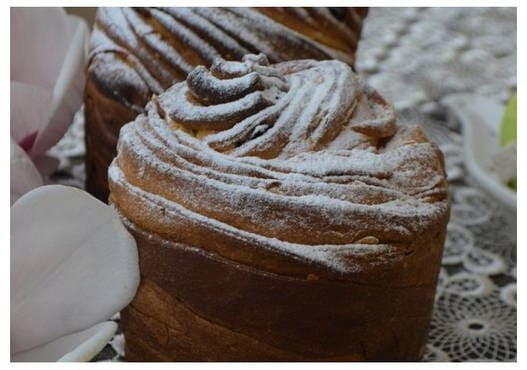Easter cake craffin
0
2315
Kitchen
Russian
Calorie content
382.9 kcal
Portions
4 port.
Cooking time
120 minutes
Proteins *
7.5 g
Fats *
17 gr.
Carbohydrates*
53.2 g
Craffin combines elements of puff croissant, classic yeast dough and dessert muffin. The cut of the finished product looks incredibly impressive. This cake, by its very appearance, creates a festive atmosphere. The dough rises well and is very pleasant to work with - soft and pliable. The billet roll is formed easily and fits into the mold conveniently. The most interesting thing is to make the first slice of the finished cake and find out what pattern the dough turned out to be?
Ingredients
Cooking process
We heat the milk on the stove or in the microwave until warm. We divide the entire volume of milk into two parts. Pour yeast and a teaspoon of granulated sugar into one part, mix. We leave the mixture in a warm place for 15-20 minutes to activate the yeast and start its work. In a separate bowl, beat the egg with yolks and sugar until fluffy.
Sift wheat flour into another container and mix it with salt. Pour the yeast mass, the second part of the milk, the beaten egg-sugar mass, melted butter into the flour. We knead the dough with our hands, add more flour if necessary. The finished dough turns out to be soft, slightly sticks to your hands. It shouldn't be cool in any way.
Put the kneaded dough on the table surface and knead for another ten to fifteen minutes, until the mass completely ceases to stick to your hands. Roll up a ball of dough and place it in a greased bowl, tighten the bowl with cling film. We put the bowl in a warm place and wait about an hour until the dough doubles in volume.
We spread the increased dough on a greased surface and divide it into the required number of parts, according to the planned number of Easter cakes. We form each part in a ball and cover with foil, leave for ten to fifteen minutes, so that the dough grows a little more. Then we roll each part in turn into rectangular layers. Lubricate the layers with an even layer of softened butter. Sprinkle washed and dried dried fruits and almond petals on top of the oil. We form the most dense roll, twisting the layer along the longest part. We keep the formed roll covered with foil while we roll out the next part of the dough.
Formed cakes are immediately placed in prepared forms.It is most convenient to use paper forms for Easter cakes: they do not need to be greased, they hold the product well during baking and transportation, and look aesthetically pleasing. If you are using regular reusable molds, you need to brush them out with a thin layer of oil using a silicone brush. Before baking, let the raw Easter cakes stand in a warm place for another hour.
For the specified time, Easter cakes should increase even more. We put them on a wire rack and place them in an oven preheated to 190 degrees on a medium level. We bake at the specified temperature for ten minutes, then reduce the temperature to 175 degrees and bake for another 25-30 minutes. To prevent the tops of the cakes from burning, you can cover them with foil after the first ten minutes of baking. We take the finished cakes out of the oven and place them on the wire rack. Let them cool completely. You can sprinkle the surface with powdered sugar through a strainer or cover with any glaze you like.
Bon Appetit!









